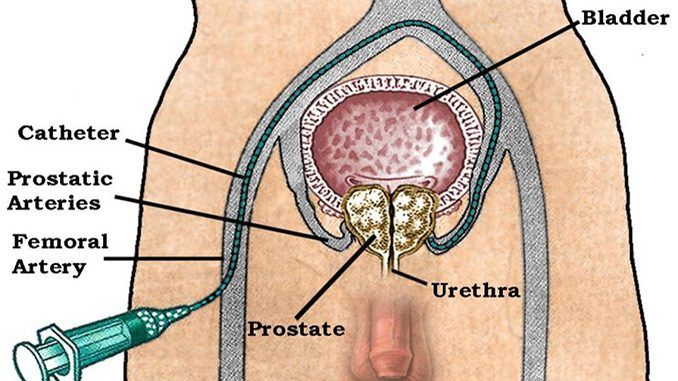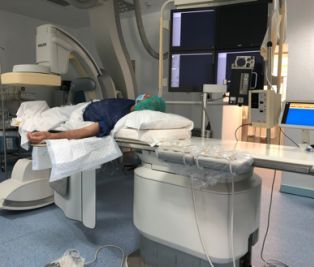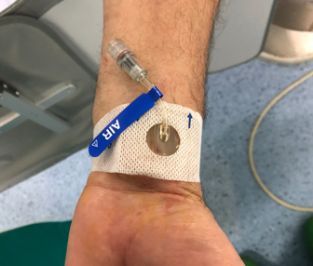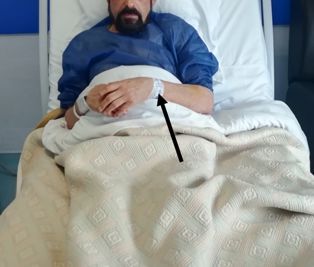Prostatic Artery Embolization
What is prostatic embolization?
Prostatic Artery Embolization (PAE) in Benign Prostatic Hyperplasia (BPH) treatment is a new application of a long-known technology used in Medicine.
Effectively, embolization is successfully performed for over half a century. The innovation was using this treatment technique in patients with benign prostatic hyperplasia (BPH).
It is a micro-invasive technique that allows the relief of the urinary tract symptoms in patients with BPH, with good results in the short, medium, and long term.

Its goal is to partially interrupt the blood circulation that irrigates the prostate, allowing the relief of the lower urinary tract symptomatology associated with BPH, as well as the reduction of the prostate size.
It is a minimally invasive technique, performed under local anesthesia, painless, and it is an outpatient treatment, with no blood loss. A small hole of 1.5 mm-diameter is made on the groin or wrist, and a small plastic tube, the catheter, is inserted.
Upon monitoring by a sophisticated digital X-ray device, the catheter is headed to the prostatic arteries.
Small-sized embolic particles, like sand grains, are then injected into the prostatic arteries, clogging parts of the branches that irrigate the prostate, sparing, however, the penis arteries, for the patient to maintain the erectile function.
The technique usually takes 1 to 2 hours to be done. The patient is conscious during the procedure and can even see it on the monitor.
When the embolization is done, the catheter is removed. We performed manual compression for 10 minutes and place a small compressive patch, which must be kept until the next morning.
The patient can stand and walk to urinate two hours after the embolization. The hospital stay lasts only a few hours and the patient is usually discharged on the same day.
How is the recovery after the prostatic embolization?

Most patients don’t feel any pain after embolization treatment. The recovery room is in a room next to the angiography room, where the embolization was performed.

If the vascular access is on the groin, a patch is placed, and you must remain in bed for 4 hours until you can start walking again.
The patient recovers in a room for 4 hours. Usually, patients don’t feel pain and can be discharged from the hospital.

If the vascular access to place the catheter is on the left wrist, at the end of the embolization you get a bracelet and you can walk freely in the room while you recover from the intervention.
How is the recovery after the prostatic embolization?

Most patients don’t feel any pain after embolization treatment. The recovery room is in a room next to the angiography room, where the embolization was performed.

If the vascular access is on the groin, a patch is placed, and you must remain in bed for 4 hours until you can start walking again.
The patient recovers in a room for 4 hours. Usually, patients don’t feel pain and can be discharged from the hospital.

If the vascular access to place the catheter is on the left wrist, at the end of the embolization you get a bracelet and you can walk freely in the room while you recover from the intervention.
How is the recovery after the prostatic embolization?

Most patients don’t feel any pain after embolization treatment. The recovery room is in a room next to the angiography room, where the embolization was performed.

If the vascular access is on the groin, a patch is placed, and you must remain in bed for 4 hours until you can start walking again.
The patient recovers in a room for 4 hours. Usually, patients don’t feel pain and can be discharged from the hospital.

If the vascular access to place the catheter is on the left wrist, at the end of the embolization you get a bracelet and you can walk freely in the room while you recover from the intervention.
The recovery is prompt. Patients can eat right after the treatment and have no pain or bleeding. Practically all patients are discharged on the same day of the procedure and can go home on their own.
The recovery is prompt and painless. You may feel burning while urinating and need to urinate several times in the first 2 days after the prostatic embolization. There can rarely be some blood on urine, sperm, or feces, but it will pass after 1 to 2 weeks.
Anti-inflammatory medication is prescribed to reduce the inflammation caused by the embolization, and an antibiotic to prevent urinary tract infection.
This medication is initiated 2 days before the embolization and must be taken for a week. Since there is usually no pain, pain medication is only used if necessary.
What happens to the prostate after the embolization?
As a result, it is possible to verify a progressive reduction of the prostate size, that differs between 10% and 60%.
However, around 10% of patients improve without changing the prostate size. The absent reduction of the prostate volume occurs mainly in patients that take pills that reduce the volume before the embolization.
As patients stop taking them after the embolization, the prostate tends to grow back, which is compensated by the embolization, since it cuts part of the prostate blood flow. The embolization is done to improve the BPH symptoms, not to reduce its size, which, however, occurs in most patients.
What is the follow-up after the prostatic embolization?
Patients are followed after 1 week, 1 month, 6 months, and 12 months after the procedure. After this period, patients are followed annually.
In these evaluations after the embolization, several surveys are filled in, and the prostatic volume is evaluated with an ultrasound or MRI. The PSA is evaluated through blood tests, and the urethral jet strength is evaluated by flowmetry.
Finally, the post-void residual (amount of urine that remains in the bladder after urinating) is evaluated through bladder ultrasound. We follow up on every patient that we have treated with embolization, including the first patients, treated since 2009!
What happens to the prostate after the embolization?
As a result, it is possible to verify a progressive reduction of the prostate size, that differs between 10% and 60%.
However, around 10% of patients improve without changing the prostate size. The absent reduction of the prostate volume occurs mainly in patients that take pills that reduce the volume before the embolization.
As patients stop taking them after the embolization, the prostate tends to grow back, which is compensated by the embolization, since it cuts part of the prostate blood flow. The embolization is done to improve the BPH symptoms, not to reduce its size, which, however, occurs in most patients.
What is the follow-up after the prostatic embolization?
Patients are followed after 1 week, 1 month, 6 months, and 12 months after the procedure. After this period, patients are followed annually.
In these evaluations after the embolization, several surveys are filled in, and the prostatic volume is evaluated with an ultrasound or MRI. The PSA is evaluated through blood tests, and the urethral jet strength is evaluated by flowmetry.
Finally, the post-void residual (amount of urine that remains in the bladder after urinating) is evaluated through bladder ultrasound. We follow up on every patient that we have treated with embolization, including the first patients, treated since 2009!
FAQ.
FAQ.
Get in Touch.
Submit the form to schedule your appointment with Dr. Tiago.
Get in Touch.
Submit the form to schedule your appointment with Dr. Tiago.





